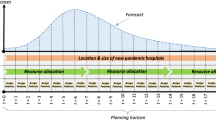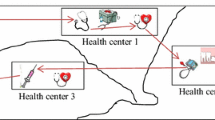Abstract
The current global pandemic of COVID-19 has caused significant strain on the medical resources of the healthcare providers, so more and more hospitals use telemedicine and virtual care for remote treatment (i.e. consulting, remote diagnosis, treatment, monitoring and follow-ups and so on) in response to COVID-19 pandemic, which is expected to deliver timely care while minimizing exposure to protect medical practitioners and patients. In this study, we study the telemedicine assignment between the patients and telemedical specialists by considering different sources of uncertainty, i.e. uncertain service duration and the no-show behavior of the doctors that is caused by the unexpected situations (i.e. emergency events). We propose a two-stage chance-constrained model with the assignment decisions in the recourse problem and employ an uncertainty set to capture the behavior of telemedical doctors, which finally gives rise to a two-stage binary integer program with binary variables in the recourse problem. We propose an enumeration-based column-and-constraint generation solution method to solve the resulting problem. A simple numerical study is done to illustrate our proposed framework. To the best of our knowledge, this is the first attempt to incorporate the behavior of doctors and uncertain service duration for the telemedicine assignment problem in the literature. We expect that this work could open an avenue for the research of telemedicine by incorporating different sources of uncertainty from an operations management viewpoint, especially in the context of a data-driven optimization framework.
Access this chapter
Tax calculation will be finalised at checkout
Purchases are for personal use only
Similar content being viewed by others
References
Ahmadi-Javid, A., Jalali, Z., & Klassen, K. J. (2017). Outpatient appointment systems in healthcare: A review of optimization studies. European Journal of Operational Research, 258(1), 3–34.
Ahmed, S., & Shapiro, A. (2008). Solving chance-constrained stochastic programs via sampling and integer programming. In: INFORMS TutORials in operations research: State-of-the-art decision-making tools in the information-intensive age. Informs (pp. 261–269).
Birge, J. R., & Louveaux, F. (2011). Introduction to stochastic programming. Springer Science & Business Media.
Charnes, A., & Cooper, W. W. (1959). Chance-constrained programming. Management Science, 6(1), 73–79.
Dai, T., & Tayur, S. (2020). Om forum—healthcare operations management: A snapshot of emerging research. Manufacturing & Service Operations Management, 22.
Deng, Y., Shen, S., & Denton, B. (2019). Chance-constrained surgery planning under conditions of limited and ambiguous data. INFORMS Journal on Computing, 31(3), 559–575.
Erdogan, S. A., Krupski, T. L., & Lobo, J. M. (2018). Optimization of telemedicine appointments in rural areas. Service Science, 10(3), 261–276.
Jebali, A., & Diabat, A. (2017). A chance-constrained operating room planning with elective and emergency cases under downstream capacity constraints. Computers & Industrial Engineering, 114(DEC.), 329–344.
Jetty, A., Moore, M. A., Coffman, M., Petterson, S., & Bazemore, A. (2017). Rural family physicians are twice as likely to use telehealth as urban family physicians. Telemedicine & E Health, 24(4), 268–276. https://doi.org/10.1089/tmj.2017.0161.
Jnr, B. A. (2020). Use of telemedicine and virtual care for remote treatment in response to covid-19 pandemic. Journal of Medical Systems, 44(7), 1–9.
Kamran, M. A., Karimi, B., & Dellaert, N. (2018). Uncertainty in advance scheduling problem in operating room planning. Computers & Industrial Engineering, 126(DEC.), 252–268.
Latifi, R., & Doarn, C. R. (2020). Perspective on covid-19: Finally, telemedicine at center stage. Telemedicine and e-Health, 26(9), 1106–1109.
Loeb, A. E., Rao, S. S., Ficke, J. R., Morris, C. D., Riley III, L. H., & Levin, A. S. (2020). Departmental experience and lessons learned with accelerated introduction of telemedicine during the covid-19 crisis. The Journal of the American Academy of Orthopaedic Surgeons, 28(11), e469–e476.
Myers, M. R. (2003). Telemedicine: an emerging health care technology. Health Care Management, 22(3), 219–223.
Noorizadegan, M., & Seifi, A. (2018). An efficient computational method for large scale surgery scheduling problems with chance constraints. Computational Optimization & Applications, 69(2), 535–561.
Qiao, Y., Ran, L., & Li, J. (2020). Optimization of teleconsultation using discrete-event simulation from a data-driven perspective. Telemedicine & e-Health, 26(1), 112–123.
Rajan, B., Tezcan, T., & Seidmann, A. (2018). Service systems with heterogeneous customers: Investigating the effect of telemedicine on chronic care. Management Science, 65(3), 955–1453.
Rajan, B., Tezcan, T., & Seidmann, A. (2019). Service systems with heterogeneous customers: investigating the effect of telemedicine on chronic care. Management Science, 65(3), 1236–1267.
Saghafian, S., Hopp, W. J., Iravani, S. M., Cheng, Y., & Diermeier, D. (2018). Workload management in telemedical physician triage and other knowledge-based service systems. Management Science, 64(11), 5180–5197.
Wang, S., Li, J., & Peng, C. (2017). Distributionally robust chance-constrained program surgery planning with downstream resource. In 2017 international conference on service systems and service management (pp. 1–6). IEEE.
Wang, S., Li, J., & Mehrotra, S. (2019). A solution approach to distributionally robust chance-constrained assignment problems. INFORMS Journal on Optimization. http://www.optimization-online.org/DB_FILE/2019/05/7207.pdf.
Wang, X., Zhang, Z., Yang, L., & Zhao, J. (2020). Price and capacity decisions in a telemedicine service system under government subsidy policy. International Journal of Production Research, 1–14.
Wang, S., Li, J., & Mehrotra, S. (2021). Chance-constrained bin packing problem with an application to operating room planning. INFORMS Journal on Computing. https://doi.org/10.1287/ijoc.2020.1010.
Ward, M. M., Jaana, M., & Natafgi, N. (2015). Systematic review of telemedicine applications in emergency rooms. International Journal of Medical Informatics, 84(9), 601–616.
Zanaboni, P., Scalvini, S., Bernocchi, P., Borghi, G., Tridico, C., & Masella, C. (2009). Teleconsultation service to improve healthcare in rural areas: acceptance, organizational impact and appropriateness. BMC Health Services Research, 9(1), 238.
Zeng, B., & Zhao, L. (2013). Solving two-stage robust optimization problems using a column-and-constraint generation method. Operations Research Letters, 41(5), 457–461.
Zhang, Y., Jiang, R., & Shen, S. (2018). Ambiguous chance-constrained binary programs under mean-covariance information. SIAM Journal on Optimization, 28(4), 2922–2944.
Zhang, Z., Denton, B. T., & **e, X. (2020). Branch and price for chance-constrained bin packing. INFORMS Journal on Computing, 32, 547–564.
Zhu, S., Fan, W., Yang, S., Pei, J., & Pardalos, P. M. (2019). Operating room planning and surgical case scheduling: a review of literature. Journal of Combinatorial Optimization, 37(3), 757–805.
Acknowledgements
This study is fully supported by the project of “Scheduling and Optimization of Telemedicine Resource from a Data-Driven Perspective” from Natural Science Foundation of China [grant 71972012]. We thank this grant support very much.
Author information
Authors and Affiliations
Corresponding author
Editor information
Editors and Affiliations
Rights and permissions
Copyright information
© 2022 The Author(s), under exclusive license to Springer Nature Switzerland AG
About this paper
Cite this paper
Ji, M., Li, J., Peng, C. (2022). Two-Stage Chance-Constrained Telemedicine Assignment Model with No-Show Behavior and Uncertain Service Duration. In: Yang, H., Qiu, R., Chen, W. (eds) AI and Analytics for Public Health. INFORMS-CSS 2020. Springer Proceedings in Business and Economics. Springer, Cham. https://doi.org/10.1007/978-3-030-75166-1_32
Download citation
DOI: https://doi.org/10.1007/978-3-030-75166-1_32
Published:
Publisher Name: Springer, Cham
Print ISBN: 978-3-030-75165-4
Online ISBN: 978-3-030-75166-1
eBook Packages: Business and ManagementBusiness and Management (R0)




